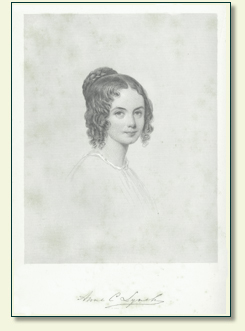|

Thomas B. Read, ed. Female
Poets of America (1849), plate opposite p. 265.
|
ANNE C. LYNCH BOTTA
(1815 – 1891)
After the death of her father, an exiled Irish patriot
seeking land in Cuba, Anne
Lynch Botta lived with her mother in Hartford,
Connecticut. At sixteen she
enrolled in the Albany Female Academy,
and, after graduating in 1834, she taught school in Albany
and Providence
while compiling work for her anthology, The
Rhode Island Book.
Settling in New
York City, Anne Lynch Botta submitted work to
periodicals, taught at the Brooklyn Girls' Academy, and began to host the
receptions for which she would eventually become famous. After a tour of Europe in 1853, she married Vincenzo Botta, an Italian
professor of literature, and together they hosted intellectual gatherings at
their home on West 37th Street.
Unlike other salons, many of which had more to do with seeing and being seen
by high society New Yorkers than with providing a creative space in which
artists could meet and collaborate, Anne Botta's receptions gained a
reputation as a gathering place for great minds, at which Edgar Allan Poe
read his early drafts of "The Raven" and Margaret Fuller
talked transcendentalism with Ralph Waldo Emerson and Horace Greeley.
Though by her own account her greatest skill was as a
hostess, she continued to write poetry, newspaper travel letters, and
critical articles for several magazines. She published Poems (1849) and A Handbook of Universal Literature
(1860), which was widely used as a textbook. She died of pneumonia in New York at the age of
seventy-five.
In 1846, Edgar Allan Poe described her in his “The
Literati of New York City. No. V,” in Godey’s Lady’s Book, v. 33, p. 133:
In
person she is rather above the usual height, somewhat slender, with dark hair
and eyes— the whole countenance at times full of intelligent expression.
Her demeanor is dignified, graceful, and noticeable for repose.
Other portraits appear in:
Sarah J. Hale, ed. Woman’s
Record (1853), p. 731; also 1855 ed.
Evert A. and George L. Duyckinck, eds. Cyclopaedia of American Literature
(1855), vol. 2, p. 628.
NEXT>
|


